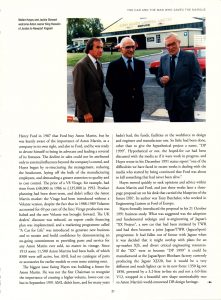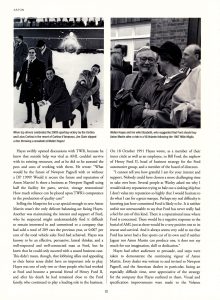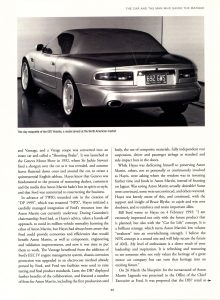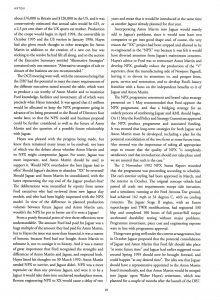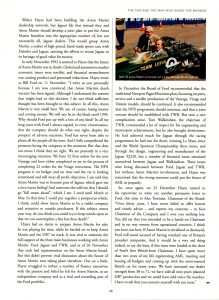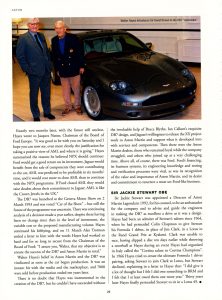The Car and the Man who Saved the Marque
Aston, issue 14, December 2012
A. S. Weatherly
courtesy and copyright of the Aston Martin Heritage Trust
www.amht.org.uk
On 14 January 1993 David Brown wrote to Walter Hayes in reply to a suggestion Hayes had made to him: “I am of course delighted and very honoured that the new Aston Martin should be designated a ‘DB’”. From what I have seen of it I am sure it will be a world beater and more than worthily uphold the ‘DB’ tradition.”
The new car needed to achieve a lot more than worthily upholding the DB tradition, it needed to save Aston Martin (AML), a company with a history of near-death experiences that was now closer to death than ever before. Naming the new car “DB7” was a great inspiration, as it revived all the powerful and positive associations that had made Aston Martin such an emotive and iconic brand, and reminded everyone involved in the car’s creation, or almost everyone, of the importance of the challenge, and the responsibility, that faced them.
When Ford bought Aston Martin in 1987 it was seen as a saviour by Aston Martin insiders, but as a threat by some outsiders for whom it was all too easy to believe that the global American company that had invented the production line could only be of harm to the hand-building craftsmanship of Aston Martin. These doubters were not close enough to an understanding of the true position Aston Martin was in to see the value to Aston Martin of Ford, and nor were they close enough to the key Ford personnel involved to know or judge their intentions.
Between 1972 and 1982 total sales were 2141, and between 1982 and 1992 they were 1855. In the year of Ford’s acquisition 224 cars were sold, and 234 the next year, but between 1988 and 1990 output dropped to 209 cars a year, although Aston Martin had the annual capacity to make 275. This was the time of a worldwide recession, a Middle East war and a US luxury tax, and the luxury car marketplace had collapsed. Between January and June of 1991, 66 Virage orders were cancelled, and worldwide dealer stocks remained static at 1.5 cars per dealer; lower than expected sales meant that many dealers were unable to finance further cars that had been allocated to them. Aston Martin showed a loss for the year of £6.6 million, and it was clear that Ford, which had been represented on the board since 1990 by Walter Hayes and Bruce Blythe, should now play a leading role.
Victor Gauntlett decided to retire as Chairman in September 1991, and Walter Hayes, a former Vice President of Ford Motor Company and Vice Chairman of Ford of Europe, was elected Chairman in his place. This was not a role Hayes had intended for himself when he suggested to Henry Ford in 1987 that Ford buy Aston Martin, but he was keenly aware of the importance of Aston Martin, as a company in its own right, and also to Ford, and he was ready to devote himself to being its advocate and leading a reversal of its fortunes. The decline in sales could not be attributed only to external influences beyond the company’s control, and Hayes began by re-structuring the management, reducing the headcount, laying off the bulk of the manufacturing employees, and demanding a greater attention to quality and to cost control. The price of a V8 Virage, for example, had risen from £48,000 in 1986 to £135,000 in 1992. Product planning had been short-term, and didn’t reflect the Aston Martin market: the Virage had been introduced without a Volante version, despite the fact that in 1988-1989 Volantes accounted for 69 per cent of the line; Virage production was halted and the new Volante was brought forward. The UK dealers’ discount was reduced, an export credit financing plan was implemented, and a marketing programme called “A Car for Life” was introduced to generate new business and to sustain and build confidence by demonstrating an on-going commitment to providing parts and service for any Aston Martin ever sold, no matter its vintage. Since 1913 some 11,500 Aston Martins had been built, of which 8500 were still active, but AML had no catalogue of parts or accessories for earlier models or even some existing ones.
The biggest issue facing Hayes was building a future for Aston Martin. He was not the first Chairman to recognise the importance of creating a higher-volume, lower-cost car, but in September 1991 AML didn’t have, and for many years hadn’t had, the funds, facilities or the workforce to design and engineer and manufacture one. So little had been done, other than to give the hypothetical project a name, “DP 1999”. Hypothetical or not, the hoped-for car had been discussed with the media as if it were work in progress, and Hayes wrote in his December 1991 status report “one of the difficulties we have faced in recent weeks is dealing with the media who started by being convinced that Ford was about to kill something that had never been alive.” Hayes moved quickly to seek opinions and advice within Aston Martin and Ford, and just three weeks later a three- page proposal sat on his desk that carried the blueprint of the future DB7. Its author was Tony Batchelor, who worked in Engineering Liaison at Ford of Europe. Hayes formally introduced the proposal in his 21 October 1991 business study. What was suggested was the adoption and fundamental redesign and re-engineering of Jaguar’s “XX Project”, a new car that had been initiated by TWR and had then become a joint Jaguar/TWR (JaguarSport) programme. It had fallen out of favour with Jaguar when it was decided that it might overlap with plans for an up-market XJS, and divert critical engineering resources. If the “XX” were to become “DP 1999” it could be manufactured at the JaguarSport Bloxham factory currently producing the Jaguar XJ220, but it would be a very different and much lighter car in its new form: 1350 kg not 1850, powered by a 3.2-litre in-line six and not a 6.0-litre V12, wrapped in a beautiful new shape unmistakably true to Aston Martin’s world-renowned DB design heritage.
Hayes swiftly opened discussions with TWR, because he knew that outside help was vital as AML couldn’t survive with its existing resources, and as he did so he assessed the pros and cons of working with them. He wrote: “What would be the future of Newport Pagnell with or without a DP 1999? Would it secure the future and reputation of Aston Martin? Is there a business at Newport Pagnell using half the facility for parts, service, vintage restorations? How much reliance can be placed upon TWR’s competence in the production of quality cars?” Selling the blueprint for a car special enough to save Aston Martin wasn’t the only delicate balancing-act facing Hayes. Another was maintaining the interest and support of Ford, who he suspected might understandably find it difficult to remain interested in and committed to a company that had sold a total of 209 cars the previous year, or 0.007 per cent of the total vehicle sales Ford had achieved. Hayes was known to be an effective, persuasive, lateral thinker, and a well-respected and well-connected man at Ford, but he knew that he could only succeed with a sound business case. This didn’t mean, though, that lobbying allies and appealing to their better sense didn’t have an important role to play. Hayes was one of only two or three people who had worked at Ford and become a personal friend of Henry Ford II, and after his death he had remained close to the Ford family, who continued to play a leading role in the business. On 18 October 1991 Hayes wrote, as a member of their inner circle as well as an employee, to Bill Ford, the nephew of Henry Ford II, head of business strategy for the Ford automotive group, and a member of the board of directors.
“I cannot tell you how grateful I am for your interest and support. Nobody could have chosen a more challenging time to take over here. Several people at Warley asked me why I would risk my reputation trying to bale out a sinking ship but I don’t value my reputation so highly that I would hesitate to do what I can for a great marque. Perhaps my real difficulty is knowing just how committed Ford is likely to be. It is neither unfair nor unreasonable to say that Ford has never really had a feel for cars of this kind. There is a reputational issue where Ford is concerned. There would be a negative response to the burial of AML just as there would be a very positive one to its rescue and survival. And it always seems very odd to me that Ford has never had a fine sports car of its own and if neither Jaguar nor Aston Martin can produce one, it does not say much for our imagination, skill or dedication.” Hayes had other audiences to persuade, and steps were taken to demonstrate the continuing vigour of Aston Martin. Every dealer was written to and invited to Newport Pagnell, and the American dealers in particular, facing an especially difficult time, were appreciative of the strategy for the company that Hayes outlined to them. Visual and specification improvements were made to the Volante and Vantage, and a Virage coupe was converted into an estate car and called a “Shooting Brake”. It was launched at the Geneva Motor Show in 1992, where Sir Jackie Stewart fired a shotgun over the car as it was revealed, and autumn leaves fluttered down onto and around the car, to create a quintessential English tableau. Hayes knew that Geneva was fundamental to the process of reassuring dealers, customers and the media that Aston Martin hadn’t lost its spirit or style, and that Ford was committed to resurrecting the business. In advance of TWR’s intended role in the creation of “DP 1999”, which was renamed “NPX”, Hayes initiated a carefully managed integration of Ford’s resources into the Aston Martin cars currently underway. During Gauntlett’s chairmanship Ford had, at Hayes’s advice, taken a hands-off approach, to avoid its million vehicle mentality harming the ethos of Aston Martin, but Hayes had always been aware that Ford could provide economies and efficiencies that would benefit Aston Martin, as well as component, engineering and validation improvements, and now it was time to put them to work. The Vantage benefitted from the addition of Ford’s EEC IV engine management system, chassis corrosion protection was upgraded to an electrocoat method already proved by Ford, and Ford test facilities were used to raise testing and final product standards. Later, the DB7 displayed further benefits of the collaboration, and featured a number of firsts for Aston Martin, including the first production steel body, the use of composite materials, fully independent rear suspension, driver and passenger airbags as standard and side-impact bars in the doors.
While Hayes was dedicating himself to preserving Aston Martin, others, not so personally or continuously involved as Hayes, were asking where the wisdom was in investing further time and funds in Aston Martin, instead of focusing on Jaguar. Was saving Aston Martin actually desirable? Some were convinced, some were unconvinced, and others wavered. Hayes was keenly aware of this, and continued, with the support and insight of Bruce Blythe, to cajole and win over doubters, and to reinforce and retain important allies. Bill Ford wrote to Hayes on 4 February 1992: “I am extremely impressed not only with the future product that is planned, but also with the “Car for Life” concept. It is a brilliant strategy, which turns Aston Martin’s low volume “weakness” into an overwhelming strength. I believe the NPX concept is a sound one and will help secure the future of AML. My level of enthusiasm is a direct result of your leadership and inspiration. It is refreshing and reassuring to see someone who not only values the heritage of a great motor car company but can turn that heritage into an exciting future.”
On 26 March the blueprint for the turnaround of Aston Martin Lagonda was presented to the Office of the Chief Executive at Ford. It was proposed that the DB7 retail at about £76,000 in Britain and $120,000 in the US, and it was conservatively estimated that annual sales would be 625, or a 2.3 per cent share of the UK sports car market. Production of the coupe would begin in April 1994, the convertible in October 1995 and the US version in January 1996. Hayes had also given much thought to other strategies for Aston Martin in addition to the creation of a new car, but was sticking to the resolve he had felt all along, and so the section of the Executive Summary entitled “Alternative Strategies” contained only one sentence: “Alternative strategies of sale or closure of the business are not recommended.” The OCE meeting went well, with the consensus being that the DB7 had the potential to meet the many requirements of the different executives seated around the table, which were to produce a car worthy of Aston Martin and to maximise Ford knowledge, facilities and investment; all of which were precisely what Hayes intended. It was agreed that £1 million would be allocated to keep the NPX programme going in advance of its being presented to the Board of Directors four weeks later, so that the NPX model and business proposal could be further considered as well as the future of Aston Martin and the question of a possible future relationship with Jaguar. Hayes was pleased with the progress being made, but knew there remained many issues to be resolved, not least of which was the debate about whether Aston Martin and its NPX might compromise Jaguar. For some, Jaguar was more important, and Aston Martin should be used to support it. Would NPX overshadow the best Jaguar had to offer? Should Jaguar’s decision to abandon “XX” be reversed? Should Jaguar and Aston Martin be consolidated, with the latter representing the top end of the Jaguar product-line? The deliberations were intensified by reports from senior Ford executives who had reviewed three new Jaguar clay models, and who had been highly impressed with the NPX model. In view of the difference in planned production volumes between future Jaguar and Aston Martin cars, wouldn’t the NPX be put to better use if it were a Jaguar?
From a purely financial point of view these reflections were understandable. The amount Ford had paid for Jaguar was a huge multiple of the amount they had paid for Aston Martin, but to Hayes the issue was more than financial, it was a matter of honour, because Ford had not bought Aston Martin to subsume it, nor to consign it to history. And it was a matter of great importance that Ford recognised the strengths and differences of Aston Martin and Jaguar, and respected both. Hayes listed his thoughts on 30 March 1992: Aston Martin needed NPX to survive, and Jaguar didn’t. NPX was a more expensive car than any previous Jaguar, and were it to be a Jaguar it would take them into uncharted marketplace waters. Reverse engineering NPX to XX would cause a delay of two years and mean that it would be introduced at the same time as another Jaguar already planned for that year.
Incorporating Aston Martin into Jaguar would merely add to Jaguar’s problems, since it would now have two companies to get into good shape and, of course, the very reason the “XX” project had been stopped and allowed to be re-engineered as the “NPX” was because it was felt it would have diverted attention from Jaguar’s mainstream concerns. Hayes’s advice to Ford was to restructure Aston Martin and develop NPX, gradually reduce the production of the “V” supercars, close the manufacturing side of Newport Pagnell, leaving it to devote its attentions to, and prosper from, parts, service and restoration, and to develop Ford’s luxury franchise with a focus on the independent benefits to it of Jaguar and Aston Martin.
The NPX program assessment and brand value strategy presented on 1 May recommended that Ford approve the NPX programme, and that a bridging strategy for an orderly process of combining Jaguar and AML should begin. On 11 May the Ford Policy and Strategy Committee approved the NPX product programme and associated funding. It was stressed that long-term strategies for both Jaguar and Aston Martin must be developed, including a plan for the potential consolidation of the two firms at some future time. Also stressed was the importance of taking all appropriate steps to ensure that the quality of NPX “is completely satisfactory and that introduction should not take place until we are assured that such is the case.”
The 2 November 1992 NPX Status Report recorded that the programme was proceeding according to schedule. The car’s exterior styling had been approved in March, and the interior in October. The original concept vehicle had passed all crash test requirements except side intrusion, and a simulator, running at the Ford Arizona Test ground, had achieved 162 mph at 34 degrees C, with no cooling concerns. The Jaguar Stage II engine, with an Eaton supercharger and TWR modifications, had registered 330 bhp and completed 100 hours of full power/full torque accelerated durability testing without major problems. Programme investment, piece cost and engineering expense were in line with programme approval.
Things were going well under the current arrangements, but in October Jaguar proposed that the potential consolidation of Jaguar and Aston Martin that Ford felt should take place “at some future time” and Jaguar had earlier suggested occur around Spring 1995 should now be brought forward, and could happen “at any desired time”. The idea was that Jaguar should have a representative appointed to the Aston Martin board immediately, and that Aston Martin would be merged into Jaguar upon Walter Hayes’s retirement, which was planned for a couple of months after the launch of the DB7.
Walter Hayes had been building the Aston Martin dealership network, but Jaguar felt that instead they and Aston Martin should develop a joint plan to put the Aston Martin franchise into the appropriate number of, but not necessarily all, Jaguar dealers. This would group Aston Martin, a maker of high-priced, hand-made sports cars, with Daimler and Jaguar, assisting the efforts to return Jaguar to its heritage of good value for money.
In early November 1992 it seemed to Hayes that the future of Aston Martin was in doubt. Global and automotive market economic issues were terrible, and financial retrenchment was causing product and personnel reductions. Hayes wrote to Bill Ford on 11 November: “I write to you personally because I am now convinced that Aston Martin’s death warrant has been signed. Although I understand the reasons that might lead to this decision, I do not think sufficient thought has been brought to this subject. In all this, Aston Martin is very small beer. We are, of course, losing money and costing money. We will not be in the black until 1994. Why should Ford put up with a loss of any kind? In all my long years with Ford I always argued, in every circumstance, that the company should do what was right, despite the prospect of adverse reactions. Ford has never been able to please all the people all the time. And I fully comprehend the pressures facing the company at the moment. But that does not mean I think they are right. We are presently in a very encouraging situation. We have 52 firm orders for the new Vantage and have either completed or are in the process of completing 22 orders for the Virage conversion. The NPX program is on budget and on time and the car is looking sensational and will meet all profit objectives. I am told that Aston Martin was to become part of Jaguar, which gave me a nice warm feeling! And someone else told me that I should go “full steam ahead”, which I am. I need until March or May. In that time I could put together a prospectus which, I think, could show Aston Martin to be a viable company and attractive to outside purchasers. If this subject comes your way, do you think you could try to keep minds open so that we can contemplate a fate less than death?”
Hayes had no desire to prepare Aston Martin for sale; he was playing for time, while he battled on to keep Aston Martin and the DB7 on track. It was vital to maintain the full support of the three main businesses working with Aston Martin: Ford, Jaguar and TWR, and as of 26 November they each had representation on the Aston Martin board. But this didn’t prevent vital discussion about the future of Aston Martin now taking place elsewhere. Out on a limb, Hayes struggled to imbue a number of finance executives with the passion and belief he felt for Aston Martin, as an independent company and as a vital and rewarding part of the Ford portfolio. after 30 years, Hayes eventually got Jackie stewart into a lotus 49!
In December the Board of Ford recommended that the traditional Newport Pagnell business plan, focussing on parts, service and a smaller production of the Vantage, Virage and Volante models, should be continued. It also recommended that the NPX programme should continue, and that a joint venture should be established with TWR. But now a new complication arose. Tom Walkinshaw, the chairman of TWR, commanded a lot of respect for his engineering and motorsport achievements, but he also brought divisiveness. He had achieved much for Jaguar through the racing programmes he had run for them, winning Le Mans twice and the World Sportscar Championship three times, and through the design, engineering and manufacture of the Jaguar XJ220, but a number of financial issues remained unresolved between Jaguar and Walkinshaw. These issues were being discussed between Ford, Jaguar and TWR, but without Aston Martin’s involvement, and Hayes was concerned that the wrong outcome could put the future of AML in jeopardy.
So, once again, on 22 December Hayes turned to his typewriter to write yet another persuasive letter to Ford, this time to Alex Trotman, Chairman of the Board: “Over thirty years, I have never failed to offer honest and timely advice – and express my concerns – to four Chairmen of the Company and I owe you nothing less. You did say that you intended to be a hands-on Chairman and in no way remote from operational concerns. I think you have one here. If Aston Martin is trivialised or destroyed, Ford will stand accused of having wrecked one of Britain’s proudest companies. And it would be a very sad thing indeed, to say the least, if this mess were landed at the door of Ford’s first British-born Chairman. I have spent more than two years of my life regenerating AML, meeting and beating all budgets and coming up with the most-wanted British car for many years. We have increased our dealer strength from 38 to 71, we have sold all next year’s planned DB7 production and we could have sold twice the number. I have to ask that you concern yourself with our issue.”
Exactly two months later, with the future still unclear, Hayes wrote to Jacques Nasser, Chairman of the Board of Ford Europe. “It was good to be with you on Saturday and I hope you can now see, even more clearly, the justification for taking a positive view of AML and where it is going.” Hayes summarised the reasons he believed NPX should continue: Ford would get a good return on its investment, Jaguar would benefit from the sale of components they were contributing to the car, AML was predicted to be profitable in six months’ time, and it would cost more to close AML than to continue with the NPX programme. If Ford closed AML they would raise doubts about their commitment to Jaguar; AML is like the Crown Jewels in the UK.”
The DB7 was launched at the Geneva Motor Show on 2 March 1993 and was voted “Car of the Show” – but still the future of the programme was uncertain. There was continuing analysis of a decision made a year earlier, despite there having been no change since then in the level of investment, the variable cost or the proposed manufacturing volume. Hayes continued his lobbying, and on 11 March Alex Trotman ended a letter to him with the words Hayes had worked so hard and for so long to secure from the Chairman of the Board of Ford: “I assure you, Walter, that my objective is to ensure the success of the DB7 and Aston Martin in total.”
Walter Hayes’s belief in Aston Martin and the DB7 was vindicated as soon as the car began production. It was an instant hit with the media and the marketplace, and 7000 were sold before production ended ten years later.
There is no doubt that Hayes was instrumental in the creation of the DB7, but he couldn’t have succeeded without the invaluable help of Bruce Blythe, Ian Callum’s exquisite DB7 design, and Jaguar’s willingness to release the XX project work to Aston Martin and support what it developed into with services and components. Then there were the Aston Martin dealers, those who remained loyal while the company struggled, and others who joined up at a very challenging time. Above all, of course, there was Ford. Ford’s financing, its business systems, its engineering knowledge and testing and verification processes were vital, as was its recognition of the value and importance of Aston Martin, and its desire and commitment to resurrect a most un-Ford-like business.
Sir Jackie Stewart OBE
Sir Jackie Stewart was appointed a Director of Aston Martin Lagonda in 1992, for his counsel, to be an ambassador for the company and to advise and guide the engineers in making the DB7 as excellent a drive as it was a design. Hayes had been an admirer of Stewart’s talents since 1964, when he had persuaded Colin Chapman to give Stewart his Formula 1 debut, in place of Jim Clark, in a Lotus in the Rand Grand Prix at Kyalami. Clark was unable to race, having slipped a disc ten days earlier while throwing a snowball at Hayes during an event Hayes had organised in Italy called the “Cortina salute to Cortina Champions”. In 1966 Hayes tried to create the ultimate Formula 1 driver pairing, asking Stewart to join Clark at Lotus, but Stewart declined, explaining in a letter to Hayes that: “I did give it a lot of thought but I felt I did owe something to BRM and I felt that I at least owed them one more year.” Thirty years later Hayes finally persuaded Stewart to sit in a Lotus 49.


